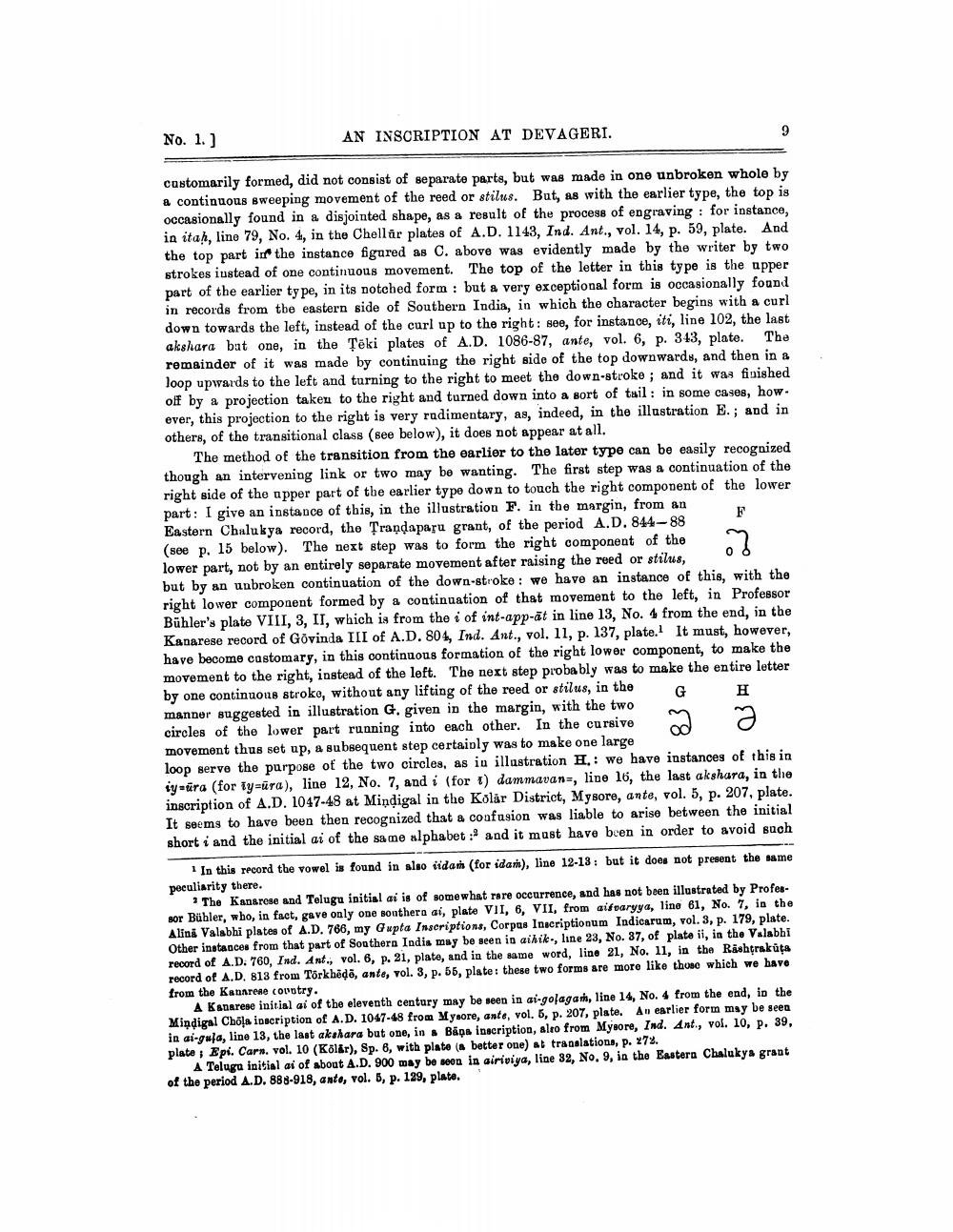________________
No. 1. )
AN INSCRIPTION AT DEVAGERI.
customarily formed, did not consist of separate parts, but was made in one unbroken whole by a continuous sweeping movement of the reed or stilus. But, as with the earlier type, the top is occasionally found in a disjointed shape, as a result of the process of engraving : for instance, in itaḥ, line 79, No. 4, in the Chellär plates of A.D. 1143, Ind. Ant., vol. 14, p. 59, plate. And the top part in the instance figured as C. above was evidently made by the writer by two strokes iustead of one continuous movement. The top of the letter in this type is the upper part of the earlier type, in its notched form : but a very exceptional form is occasionally found in records from the eastern side of Southern India, in which the character begins with a curl down towards the left, instead of the curl up to the right: see, for instance, iti, line 102, the last akshara bat one, in the Teki plates of A.D. 1086-87, ante, vol. 6, p. 343, plate. The remainder of it was made by continuing the right side of the top downwards, and then in & loop upwards to the left and turning to the right to meet the down-stroke ; and it was finished off by a projection taken to the right and turned down into a sort of tuil : in some cases, how. ever, this projection to the right is very rudimentary, as, indeed, in the illustration E.; and in others, of the transitional class (see below), it does not appear at all.
The method of the transition from the earlier to the later type can be easily recognized though an intervening link or two may be wanting. The first step was a continuation of the right side of the apper part of the earlier type down to touch the right component of the lower part: I give an instance of this, in the illustration F. in the margin, from an Eastern Chalukya record, the Trandaparu grant, of the period A.D. 844-88 (see p. 15 below). The next step was to form the right component of the lower part, not by an entirely separate movement after raising the reed or stilus, but by an unbroken continuation of the down-stroke: we have an instance of this, with the right lower component formed by a continuation of that movement to the left, in Professor Bühler's plate VIII, 3, II, which is from the i of int-app-āt in line 13, No. 4 from the end, in the Kanarese record of Govinda III of A.D. 804, Ind. Ant., vol. 11, p. 137, plate. It must, however, have become customary, in this continuous formation of the right lower component, to make the movement to the right, instead of the left. The next step probably was to make the entire letter by one continuous stroke, without any lifting of the reed or stilus, in the
G H manner suggested in illustration G. given in the margin, with the two circles of the lower part running into each other. In the cursive movement thus set up, a subsequent step certainly was to make one large loop serve the purpose of the two circles, as in illustration H.: we have instances of this in iy=ūra (for ty-ra), line 12, No. 7, and i (for 1) dammavans, line 16, the last akshara, in the inscription of A.D. 1047-48 at Mindigal in the Kolar District, Mysore, ante, vol. 5, p. 207, plate. It seems to have been then recognized that a confusion was liable to arise between the initial short i and the initial ai of the same alphabet :' and it must have been in order to avoid such
In this record the vowel is found in also iidan (for idan), line 12-18 : but it does not present the same peculiarity there.
The Kanarose and Telugu initial ai is of somewhat rare occurrence, and has not been illustrated by ProfesBor Bühler, who, in fact, gave only one southera ai, plate VII, 6, VII, from aif varyya, line 61, No. 7, in the Alins Valabhi plates of A.D. 766, my Gupta Inscriptions, Corpus Inscriptionum Indicarum, vol. 3, p. 179, plate. Other instances from that part of Southern Indis may be seen in aihik., line 23, No. 37, of plate ii, in the Valabhi record of A.D. 760, Ind. ant., vol. 6, p. 21, plate, and in the same word, line 21, No. 11, in the Rashtrakūta record of A.D. 813 from Torkbodo, ante, vol. 3, p. 56, plate: these two forms are more like those which we have from the Kanarese country.
A Kadarese initial ai of the eleventh century may be seen in ai-golagarh, line 14, No. 4 from the end, in the Mindigal Chola inscription of A.D. 1047-48 from Mysore, ante, vol. 5, p. 207, plate. An earlier form may be seen in ai-gula, line 13, the last akshara but one, in Bapa inscription, alto from Mysore, Ind. Ant., vol. 10, P. 39, plate, Epi. Carn. vol. 10 (Kolár), Sp. 6, with plate a better one) s translations, p. 272.
A Teluga initial ai of about A.D. 900 may be soon in airiviya, line 82, No. 9, in the Eastern Chalukys grant of the period A.D. 888-918, anto, vol. 5, p. 129, plate.
(%




